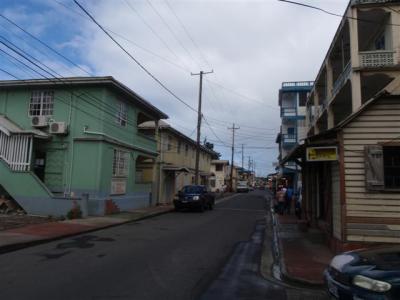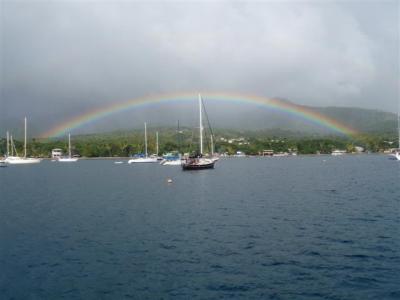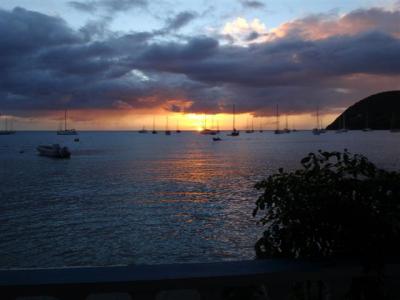The other day, Barb and Chuck had invited us to go visit Cabrits National Park, on the Cabrits peninsula right near where we are anchored. We had mentioned on the day that we arrived that the north end of the bay had a few isolated buildings and a nice dock. We later found out those are part of Fort Shirley, a restored old British fort on the Cabrits peninsula. We had enthusiastically Continue reading
Monthly Archives: April 2009
Sperm Whale Watching Part 2
Continued from yesterday… Sperm whales dive the longest and deepest of all the whale species, going down between 1.3 km deep and staying down about an hour. The longest recorded dive is 2 hours and 40 minutes. They will come back up for about 20 minutes to re-oxygenate their blood, then dive back down to continue hunting. There is no light that deep, so have an amazing sonar system to find food. They primarily eat squid, and have the most powerful sonar system of any animal. Males can reach up to 60 feet and 125,000 lbs. (18m and 60 m tones). Females are ½ the length and 1/3 of the weight of males. Babies are about 13 feet and 2200 lbs (4m and 1 m tonne) at birth. Sperm whales live between 50 and 70 years and can be found just about everywhere in the world with waters deeper than 3,000 feet (1,000m).
Female sperm whales travel in groups, along with their calves, and live in tropical or sub-tropical waters all year. A female sperm whale starts breeding at about 12 and continues to breed into her 40’s. She has an 18 month gestation period. When her calf is around two years old, she will breed again, so each female has about one baby every 4 years or so, delivering about 10 calves in her lifetime. The babies can’t stay underwater for very long, so one female at a time will stay on the surface with the baby as the others hunt for food. When the whales sleep on the surface, they make a ring with their heads in the center and their tail fins out. They put baby in middle, and thus are able to shoo off any potential predators with their fins.
The male whales migrate away when they are between 6 and 9 years old. They are not exactly sure where the males go, but it is almost certainly to colder waters up north, and possibly even the Arctic Circle. After being gone for 15 years, the males come back to tropical waters to mate. They meet up with a female for a season, then move on again. Part of his research is on the whale cultural groups. Whales have distinctive cultural groups with learned behavior patterns and dialects, just like humans. And, like humans, they communicate primarily via sounds. The whales instinctively know not to mate with someone who speaks their own dialect. It is nature’s way of preventing inbreeding.
And why are they called sperm whales? The whales have Continue reading
Reminder for Kosmos Return to San Diego, Saturday May 02
Just a reminder, see the Where in the World Are We post. It has information on where to see us on our return to San Diego on Saturday, May 02, 2009.
Also, as we get back into the land of fast Internet we can tweak the blog a bit. For example we have added 3 new sub-categories of Boat Technical, which are: Maintenance, Repair, and Failure.
In general our categories are pretty accurate, but we may have missed some. If you think any stories are miscategorized let us know.
Trip to Roseau to Go Sperm Whale Watching
Today we went to Roseau, the capital city on the southwest side of the island, to go whale watching. Around Dominica there are sperm whales in the water all year. One particular whale watch company has a 90% success rate in spotting them. So, we decided it was worth the money. We headed to shore in the early morning. The tour wasn’t until 1330, but we had no idea how long it would take to get to Roseau, and we figured we could get some sightseeing in before the whale watch.
We are sad to admit this, but we have been here for 5 days now and have not explored Portsmouth yet. That is so out of character for us. Usually, the first thing we do after pulling into a new port is check out the town. We mentioned that there are three restaurants with dinghy docks. All are on the northern end of town, so when we have gone to shore to eat, we stayed to the north, and it was usually dark, so we didn’t see much.
The beach here is black sand. We walked beyond the beach and out to the road, heading south toward the town center. The road paralleling the shore is probably the main drag. It is lined with buildings, most small bungalows. Some are in good shape, some are dilapidated, and most are weather beaten but habitable. It looks to us like the individual lots tend to have several buildings crammed on them.
It is only a few blocks walk to the heart of town. The ambiance changed palpably. The buildings became more commercial looking, closer together, and better maintained (though most still looked like they could use a coat of paint and a little general work).

The bus stop is just north of Indian River. It was a parking lot with several nice mini-vans just like the one Winston was driving. We walked up and Continue reading
SCUBA Diving Cabrits Point, Dominica
Yesterday it rained for most of the day. It was a good reason to stay home and do much needed chores. Dominica has a ton of activities to offer, but almost all of them are outdoors, and most involving hiking. In the morning and early afternoon we worked on the bottom and water line. When Christi hopped in, she was horrified. It was the worst she has ever seen it. The grass was thick and long, and there were barnacles galore. She worked on the bottom for 45 minutes, until her tank was empty (the tank wasn’t full when she started). When she came up, Eric decided to give it a go. He hooked up a tank and jumped in. He was in the water a total of an hour. Like Christi, he worked on the bottom until he ran out of air (he also was not on a full tank), then worked on the waterline. The bottom looks a heck of a lot better, but we still have a long way to go. Sigh. The good news is that the water in the bay is amazingly clear. And we are amused to report that we have some fish living under our boat. Check out the beautiful rainbow.

There are three restaurants that have dinghy docks for the cruisers to use, so we went to one of them for dinner. We both got a conch plate, which was served with an absolutely delicious sauce. The conch was perfectly tender, and not at all rubbery. It was served with mixed veggies, including christophene. It also came with a cooked banana or plantain (delicious), a piece of plain yam and a couple pieces of plain taro (both quite tasteless), lightly seasoned rice, and beans that had a little zest (quite good). It was nice to see such a full plate of food with so many little side dishes. It is almost a Guadeloupe style meal, except in Guadalupe all the sides would have been more elaborate.
Check out the pretty sunset from the resturant:

While on shore, we booked a dive trip for this morning. We grilled the poor owner, asking her dozens and dozens of questions before we committed to diving. She must think we are freaks, but after being so unhappy with our last two dive companies, we figured we were being prudent. The fee was Continue reading
